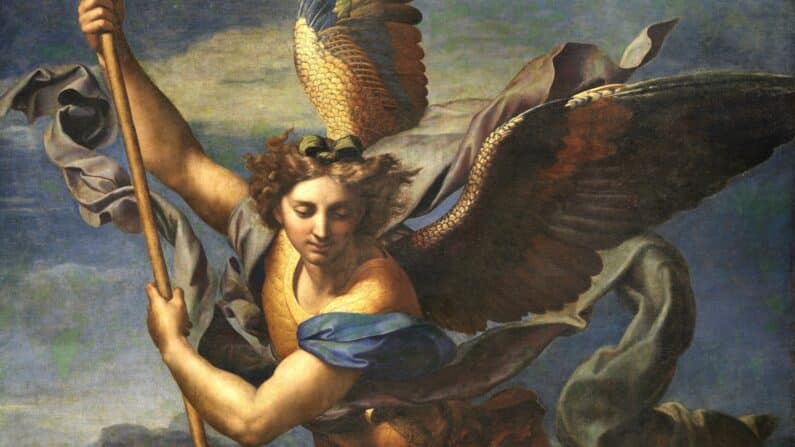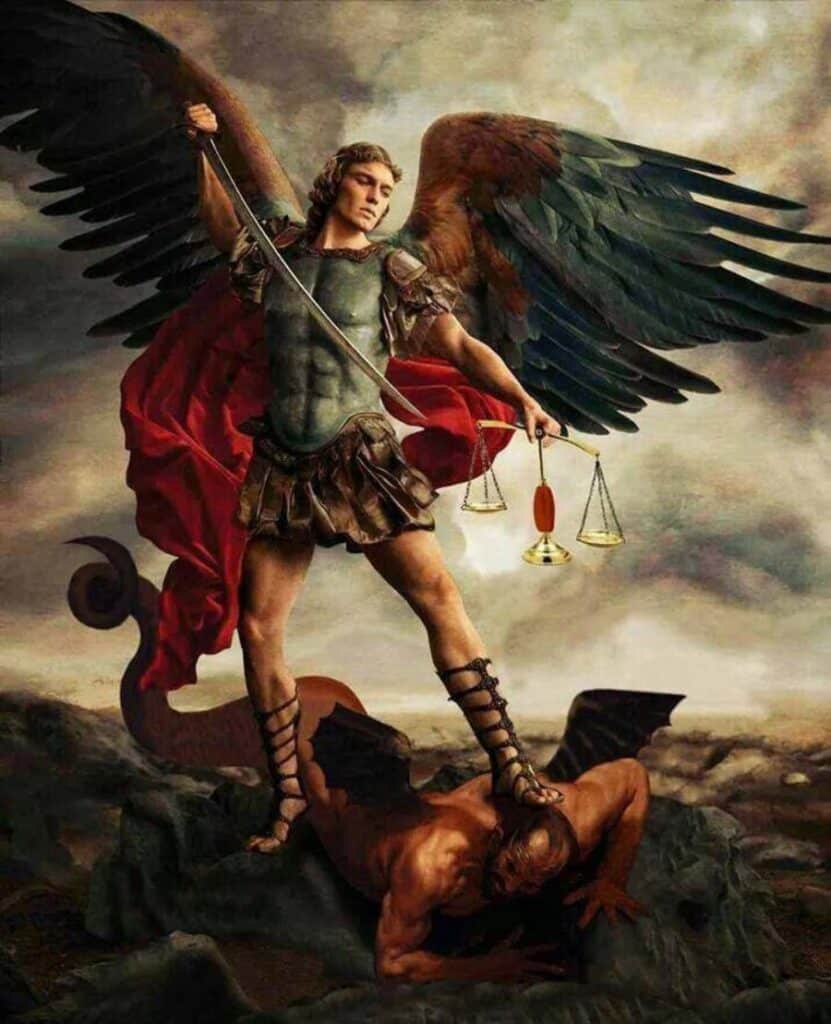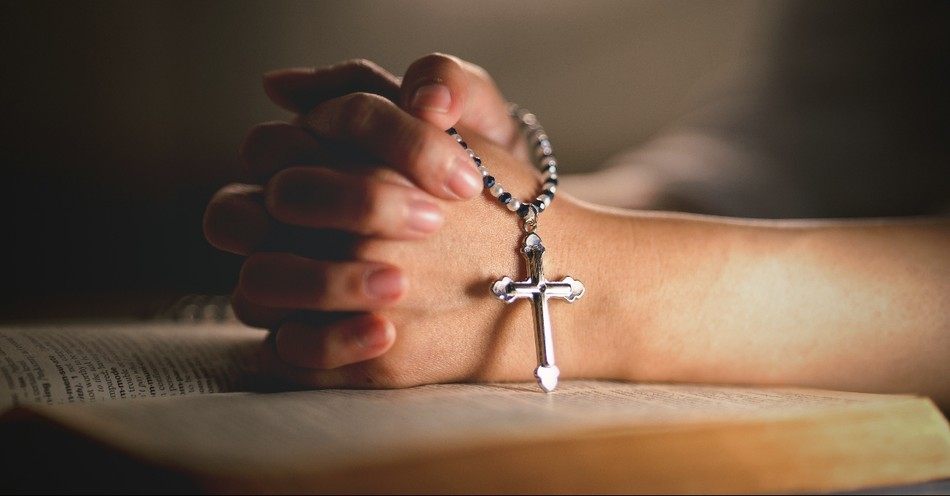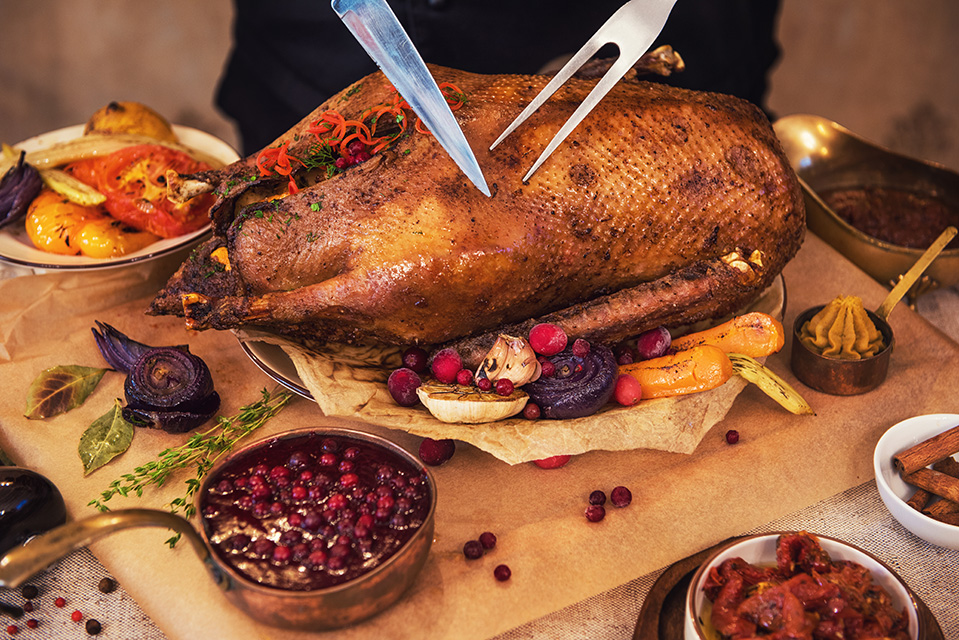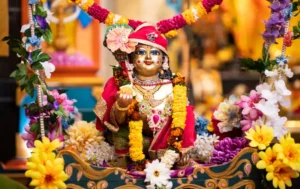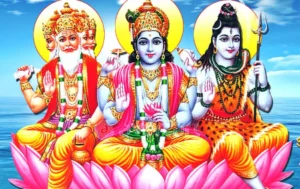Archangel Michael stands as one of the most revered and formidable figures in the spiritual realms across various religious traditions. Known primarily as a protector, a warrior of righteousness, and a leader among angels, Michael occupies a unique and powerful position.
His name, meaning “Who is like God?”, underscores his role as a divine champion, embodying the virtues of strength, courage, and justice. Venerated in Christianity, Judaism, and Islam, Michael’s influence spans scriptural texts and centuries of faith, appearing as a guiding light during times of turmoil and a staunch defender against evil.
Who is Archangel Michael?
Archangel Michael, often depicted as a powerful and celestial warrior, holds a prominent position in Christian, Jewish, and Islamic traditions. Known as the protector against evil, Michael is revered for his role as a divine combatant, defending the faithful against the forces of darkness.
In Christian theology, Michael is often seen as the leader of God’s armies, famously portrayed in the Book of Revelation as the conqueror of Satan during the celestial battle: “And there was war in heaven, Michael and his angels fought against the dragon; and the dragon fought and his angels, and prevailed not” (Revelation 12:7-8). This image cements his role as a protector and a figure of heavenly authority who enforces divine justice.
Judaism recognizes Michael as a guardian angel, attributed to guiding and protecting Israel throughout its history. In the Talmud, Michael is described as one of the chief princes who stands up for the rights of Israel against its accusers in heaven. He is also a figure of mercy, interceding on behalf of humanity before God.
In Islam, Michael (known as Mikail) is one of the four archangels and is responsible for providing nourishments for bodies and souls. He is also seen as a provider of rain and sustenance, emphasizing his role in life’s cyclical nature and the well-being of humanity.
Artistically, Archangel Michael is typically depicted wielding a sword or a lance while donning armor, often in the act of defeating a dragon, which symbolizes Satan. This portrayal not only highlights his martial prowess but also symbolizes the triumph of good over evil.
Devotion to Michael includes numerous feasts and dedications to him across various Christian denominations. One of the most notable is the Feast of Saint Michael, celebrated on September 29, commemorating Michael’s heavenly victory and his ongoing protection of the Church.
As a figure of strength, righteousness, and divine protector, Archangel Michael’s presence resonates in religious art, prayer, and across cultures, embodying the eternal battle against evil and the assurance of divine protection. His story encourages the faithful, offering reassurance of the moral order upheld by divine beings committed to the welfare of humanity.
Mission of Archangel Michael
The mission of Archangel Michael is multifaceted but consistently centers around protection, justice, and spiritual guidance. His role as a celestial guardian and warrior marks him as a unique entity within the angelic hierarchies, tasked with specific duties that underscore his importance across faiths.
Protector and Defender: Archangel Michael’s primary mission is to protect the faithful from spiritual and physical harm. This is vividly illustrated in Christian scriptures where he leads God’s armies against Satan’s forces, ensuring the safety and sanctity of heaven and its inhabitants. Similarly, in personal devotions, believers often invoke Michael for protection against evil and guidance during challenging times.
Leader of the Heavenly Hosts: In his role as a military leader, Michael exemplifies leadership and valor. This is not only in the cosmic battle described in the Book of Revelation but also in his ongoing vigilance against evil, defending the cosmos from the forces of darkness. His leadership extends to guiding and supporting other angels in their divine duties.
Agent of God’s Justice: Michael is often seen as a figure of divine justice. In many depictions, he holds scales that measure the souls of the deceased, symbolizing his role in the final judgment. This representation underscores his function in maintaining cosmic balance and moral order.
Intercessor and Healer: In addition to his warrior aspects, Michael also serves as an intercessor. In both Christian and Jewish traditions, he intercedes for humanity before God, advocating for mercy over strict justice. This role highlights his compassionate nature and his commitment to the welfare of humans.
Symbol of Faith and Moral Resolve: Through his unwavering commitment to God’s commands and his role in the cosmic order, Michael also serves as a spiritual exemplar for the faithful. He inspires courage, fortitude, and faithfulness, helping believers to stand firm in their convictions and to resist the temptations and trials that they face.
Cultural and Spiritual Influence: Archangel Michael’s mission transcends the boundaries of heaven and earth, influencing cultural practices and spiritual beliefs. He is a patron saint of soldiers, police officers, and others who, like him, are tasked with protecting society. His influence is evident in religious art, literature, and the naming of countless churches and cathedrals dedicated to him.
Symbols Associated with Archangel Michael
Archangel Michael is associated with a variety of symbols that encapsulate his role and importance in religious traditions. These symbols are not only representations of his celestial duties but also serve as instruments through which believers can invoke his protection and guidance. Here are some of the most emblematic symbols associated with Archangel Michael:
Sword: Perhaps the most iconic symbol of Michael is the sword. This represents his function as a warrior of God, battling the forces of evil. The sword symbolizes the cutting away of all ties to sin and evil, and Michael wielding it is a powerful image of the triumph of good over evil.
Shield: Often accompanying the sword is a shield bearing the sign of the cross or another Christian motif. This shield symbolizes protection, reflecting Michael’s role as a divine protector who shields the faithful from spiritual harm. It is also a metaphor for faith being a shield against the trials and tribulations of life.
Scales: In many artistic depictions, especially those emphasizing his role in the final judgment, Michael is shown holding scales. These scales are used to weigh the souls of the deceased, a symbol of his role in assessing the moral worth of a soul. The scales underscore his association with divine justice and the eternal laws of God.
Armor: Archangel Michael is frequently depicted wearing armor, reinforcing his identity as a celestial soldier. This armor not only signifies his role in defending against spiritual enemies but also symbolizes his invulnerability to evil and sin.
Dragon: The dragon is a symbol of the evil that Michael conquers, most famously portrayed in the story of his battle against Satan, who is often depicted as a dragon. This image represents Michael’s victory over chaos and evil, reinforcing his role as a protector and warrior.
Blue and Red Robes: In iconography, Michael is often dressed in robes of blue and red. Blue represents the celestial and divine nature of Michael, while red symbolizes his role as a warrior, willing to shed blood in the cosmic battle against evil.
Flaming Sword: Beyond a regular sword, Michael is sometimes shown with a flaming sword. This image has biblical roots in the story of Adam and Eve, where a cherub with a flaming sword guards the gates of Eden. The flaming sword represents spiritual light and truth, cutting through deception and sin.
The Signs of Archangel Michael’s Presence
Archangel Michael’s presence is believed to be signaled by various signs and sensations that resonate with the spiritual experiences of many believers. Recognizing these signs can provide comfort and affirmation of Michael’s protective influence in times of need. Here are some commonly reported signs that indicate the presence of Archangel Michael:
- Sudden Changes in Temperature: A sudden warmth or coolness in the environment without a discernible source is often reported by individuals who feel the presence of Archangel Michael. This change in temperature is seen as a comforting sign of his protective energy enveloping the space.
- Feelings of Peace and Calm: In moments of anxiety or fear, a sudden sense of peace and tranquility can be a sign of Archangel Michael’s presence. This feeling of calm reassurance is believed to help individuals face challenges with renewed courage and clarity.
- Blue and Purple Light Flashes: Visual manifestations such as flashes of blue or purple light are often associated with Michael, whose traditional colors symbolize his royal and protective nature. These flashes might occur in your peripheral vision or in meditation, suggesting his nearness.
- The Scent of Flowers: Unexplained floral scents, especially those that are not physically present, are sometimes attributed to the presence of angels, including Michael. These scents are perceived as a sign of his comforting and protective presence.
- Dreams and Visions: Michael might appear in dreams or visions to provide guidance or reassurance. In these dreams, he may communicate messages of encouragement or offer solutions to problems, often emphasizing strength and resilience.
- Feathers: Finding feathers, particularly in unexpected places, is a common sign associated with angelic presence. A feather may appear when thinking about or praying to Michael as a symbol of his listening and protective aura.
- Audible Voices: Hearing a voice when alone, especially one providing guidance or reassurance, can be interpreted as Michael’s presence. The voice is often commanding yet comforting, reflecting his role as a leader and protector.
- A Sense of Being Watched Over: A general feeling of not being alone, that someone is watching over or guarding you, can be a subtle yet profound sign of Michael’s presence. This sensation often brings with it an uplifted spirit and a renewed sense of hope.
Recognizing these signs requires a level of spiritual sensitivity and openness. For those who believe, these experiences are deeply meaningful, providing them with strength and comfort, especially in times of uncertainty or distress.
How to Communicate with Archangel Michael
Communicating with Archangel Michael is a practice valued by many who seek guidance, protection, and support from this powerful celestial being. While spiritual communication varies among individuals, there are common methods that can help foster a connection with Archangel Michael. Here’s how you can reach out to and communicate with him:
- Prayer: The simplest and most direct way to communicate with Archangel Michael is through prayer. Address him directly with specific requests or simply speak to him about your concerns. Prayers to Michael often involve asking for courage, protection, and help in overcoming negative or harmful influences.
- Meditation: Meditation can provide a quiet space for spiritual connections to occur. To connect with Archangel Michael during meditation, visualize a strong, protective presence surrounding you with a blue or purple light. Focus on the attributes of Michael—strength, protection, righteousness—and invite his presence into your meditation space.
- Invocations and Affirmations: Use invocations or affirmations that call upon Archangel Michael’s assistance. These can be specific statements like, “Archangel Michael, I invoke your presence and protection,” repeated as a mantra. Affirmations help set intentions and open pathways for spiritual communication.
- Writing Letters: Write a letter to Archangel Michael detailing your thoughts, fears, hopes, and questions. This act can be a form of prayer and is often a deeply personal way to connect with the divine. You can keep the letter in a special place or perform a small ritual by burning the letter to send it to the spiritual realm.
- Lighting Candles: Lighting a blue candle can be an act of calling upon Archangel Michael. The blue candle represents Michael’s spiritual presence and can be used during prayer or meditation. The act of lighting the candle is a physical manifestation of your intention to connect with him.
- Wearing Symbols: Wearing symbols associated with Archangel Michael, such as pendants or bracelets featuring swords or shields, can help keep you mindful of his presence and protection throughout the day. These symbols serve as reminders of your connection to him.
- Reading Sacred Texts: Engage with passages in sacred texts that mention Michael, such as the Book of Revelation in the Bible or other scriptural texts where he is featured. Reflecting on these passages can help you feel closer to Michael and understand his role and influence.
- Creating an Altar: Set up a small altar dedicated to Archangel Michael in your home. This can include images or statues of Michael, candles, and other items that represent him. This dedicated space can serve as a focal point for your prayers and meditations.
When communicating with Archangel Michael, it’s important to approach with a clear and open heart. The sincerity of your intention is crucial in spiritual communication.
Some Biblical Stories Involving Archangel Michael
Archangel Michael, one of the most revered figures in religious lore, is prominently featured in several biblical texts. Here are some notable biblical stories that involve Archangel Michael:
1. The Book of Daniel: Archangel Michael appears several times in the Book of Daniel, which is part of the Hebrew Bible and the Christian Old Testament. In Daniel 10:13-21, Michael is described as one of the chief princes who comes to help the angel Gabriel, who is struggling against the prince of the Persian kingdom. Michael is depicted as a protector of Israel, standing against the spiritual forces opposing God’s plans. Again in Daniel 12:1, he is referred to as the great prince who protects God’s people and will arise during the end times, a time of distress unmatched from the beginning of nations.
2. The Book of Jude: In the New Testament, the Book of Jude (verse 9) contains a brief yet significant mention of Michael in a dispute with the devil over the body of Moses. This episode, which does not appear elsewhere in the canonical texts of the Bible, shows Michael arguing with Satan and saying, “The Lord rebuke you!” This story highlights Michael’s role as a defender of the faith and executor of divine justice, even in matters concerning the afterlife of the righteous.
3. The Book of Revelation: Perhaps the most dramatic portrayal of Michael in the Bible is found in Revelation 12:7-9. In this apocalyptic vision, Michael leads God’s angels in a war against the dragon, identified as the devil or Satan, and his angels. The text depicts Michael as a powerful leader in the celestial battle, ultimately triumphing over evil and casting the dragon out of heaven. This story reinforces Michael’s role as a divine warrior and protector of heaven’s order against chaos and evil.
These biblical narratives paint Archangel Michael as a formidable force against evil, a guardian of the people of God, and a leader in the spiritual realm. His presence in scripture spans from being a guide and protector to a warrior leading the forces of heaven, illustrating the broad and powerful role he plays in the divine cosmos according to biblical tradition. These stories not only highlight his significance in the spiritual hierarchy but also serve as a source of inspiration and comfort to those who seek his protection and guidance.
The Feast Day of Archangel Michael
The feast day of Archangel Michael, known as Michaelmas, is a significant observance in many Christian denominations, celebrated with reverence and festive traditions.
This feast occurs annually on September 29th and honors Archangel Michael’s role as a celestial warrior and protector against evil. Michaelmas not only commemorates Michael’s victories in the spiritual realm but also serves as a reminder of the angelic support believers have in the fight against darkness.
Historically, Michaelmas marks the end of the harvest season and the beginning of autumn. In medieval times, it was considered a momentous holy day, associated with the settling of accounts and the preparation for the colder months ahead. The day was often marked by feasting, with goose being the traditional dish, as it was believed that eating goose on Michaelmas would ensure financial prosperity in the months to come.
In addition to its agricultural significance, Michaelmas is deeply embedded in the liturgical life of the Church. Special prayers, hymns, and scripture readings that recount the exploits and virtues of Archangel Michael are a hallmark of the day’s services. Icons and statues of Michael are also prominently displayed and venerated, emphasizing his ongoing role as a guardian of the faithful.
Michaelmas is not only celebrated in Western Christianity but also observed by the Eastern Orthodox Church, albeit on different dates depending on the liturgical calendar used—either on November 8th or September 6th. These observances highlight the global and ecumenical recognition of Archangel Michael’s significant spiritual leadership and protective grace.
For the faithful, Michaelmas is a day of spiritual renewal and affirmation, providing an opportunity to reflect on the themes of good versus evil, spiritual warfare, and the role of angels in God’s cosmic plan. It encourages believers to seek the protection and guidance of Archangel Michael and to strive for righteousness, echoing the angel’s unwavering commitment to the divine will.


